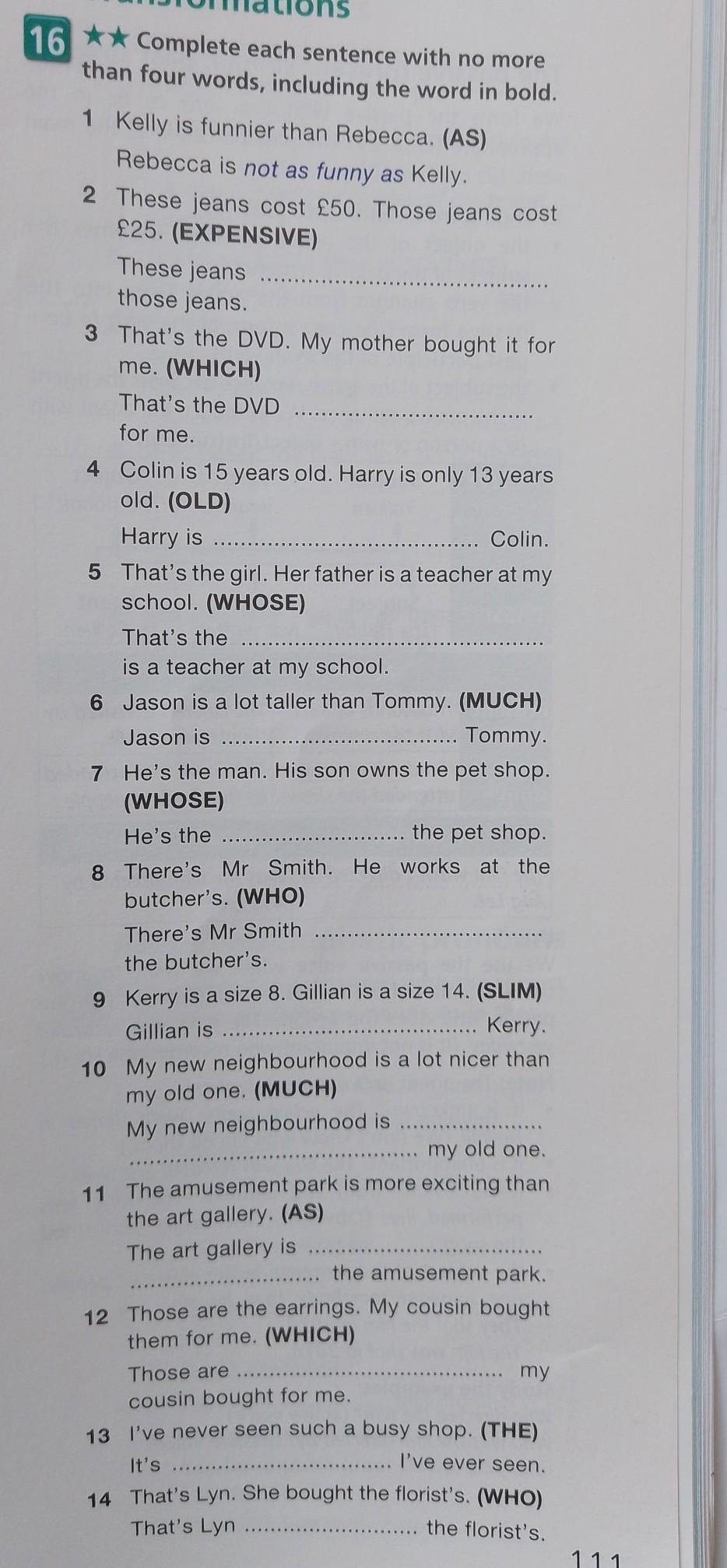Complete each sentence with no more
than four words, including the word in bold. 1 Kelly is funnier than Rebecca. (AS)
Rebecca is not as funny as Kelly. 2 These jeans cost £50. Those jeans cost
£25. (EXPENSIVE) These jeans
those jeans.
That's the DVD. My mother bought it for
me. (WHICH)
3
That's the DVD for me. 4 Colin is 15 years old. Harry is only 13
years old. (OLD)
Harry is .....
Colin
5 That's the girl. Her father is a teacher at my school. (WHOSE)
That's the is a teacher at my school.
6 Jason is a lot taller than Tommy. (MUCH)
Jason is...... Tommy. 7 He's the man. His son owns the pet shop. (WHOSE)
He's the
the pet shop.
8 There's Mr Smith. He works at the
butcher's. (WHO)
There's Mr Smith the butcher's.
9 Kerry is a size 8. Gillian is a size 14. (SLIM) ........ Kerry.
Gillian is........ 10 My new neighbourhood is a lot nicer than
my old one. (MUCH) My new neighbourhood is
..... my old one. 11 The amusement park is more exciting than the art gallery. (AS) The art gallery is
the amusement park. 12 Those are the earrings. My cousin bought them for me. (WHICH)
Those are cousin bought for me..
13 I've never seen such a busy shop. (THE) It's......... ......I've ever seen.
14 That's Lyn. She bought the florist's. (WHO) That's Lyn
........the florist's.
my
ДАЮ 40 БАЛІВ!
Ответы
Ответ:
2 These jeans cost £50. Those jeans cost £25. (EXPENSIVE)
These jeans are more expensive than those jeans.
3 That's the DVD. My mother bought it for me. (WHICH)
That's the DVD which my mother bought for me.
4 Colin is 15 years old. Harry is only 13 years old. (OLD)
Harry is not as old as Colin.
5 That's the girl. Her father is a teacher at my school. (WHOSE)
That's the girl whose father is a teacher at my school.
6 Jason is a lot taller than Tommy. (MUCH)
Jason is much taller than Tommy.
7 He's the man. His son owns the pet shop. (WHOSE)
He's the man whose son owns the pet shop.
8 There's Mr Smith. He works at the butcher's. (WHO)
There's Mr Smith who works at the butcher's.
9 Kerry is a size 8. Gillian is a size 14. (SLIM)
Gillian is not as slim as Kerry.
10 My new neighbourhood is a lot nicer than my old one. (MUCH)
My new neighbourhood is much nicer than my old one.
11 The amusement park is more exciting than the art gallery. (AS)
The art gallery is not as exciting as the amusement park.
12 Those are the earrings. My cousin bought them for me. (WHICH)
Those are the earrings which my cousin bought for me.
13 I've never seen such a busy shop. (THE)
It's the busiest shop I've ever seen.
14 That's Lyn. She bought the florist's. (WHO)
That's Lyn who bought the florist's.
Объяснение:
Для выполнения этого задания нужно знать 1) различные конструкции, используемые для сравнения предметов или людей, а также 2) правила употребления относительных местоимений who, which, whose.
1. Когда нужно сказать, что два предмета имеют одинаковое качество, используется сравнительный оборот AS…AS… — такой же… как, и…
В этом случае прилагательное имеет положительную степень, то есть используем слово в его обычной основной форме:
My book is as interesting as yours. - Моя книга такая же интересная, как и твоя.
При отрицании равенства качеств двух предметов используется тот же оборот, только с частицей not: NOT AS…AS …. или NOT SO… AS… (не такой…, как… ):
Rebecca is not as funny as Kelly. - Ребекка не такая смешная, как Келли.
При сравнении двух предметов неравного качества употребляется союз THAN (чем) с прилагательным в сравнительной степени:
These jeans are more expensive than those jeans. - Эти джинсы дороже, чем те.
Для усиления сравнения (см. предложения 6 и 10) могут добавляться слова:
much — намного
far — гораздо
by far — безусловно
a lot — значительно
a little — немного
even — даже
Превосходная степень сравнения прилагательных отличается тем, что перед прилагательным ставится определенный артикль the:
It's the busiest shop I've ever seen. - Это самый загруженный (напряженно работающий) магазин, который я когда-либо видел.
2) Относительные местоимения who, which, whose используются для присоединения придаточных определительных предложений.
Слово who (кто, который) используется для связки придаточного предложения с главным в роли подлежащего. В этом значении who указывает только на людей, иногда домашних животных - см. пример в пунктах 8 и 14.
Which (который) используется для указания на предметы, явления, животных. См. пункты 3 и 12.
Whose (чей) в придаточном предложении выражает принадлежность какого-либо предмета или лица какому-либо лицу. В этом значении whose используется по отношению к людям или животным, но в официальном стиле может указывать на предметы. Примеры в пунктах 5 и 7.
#SPJ1
